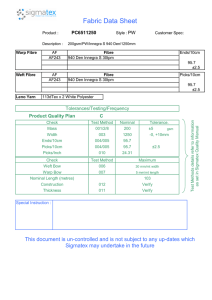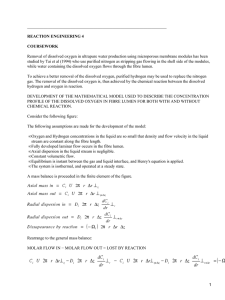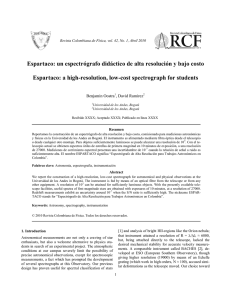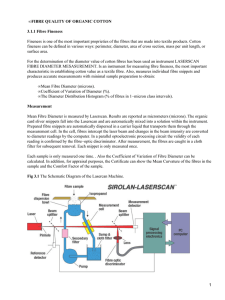Quality characteristics of Huacaya alpaca fibre - Academica-e
Anuncio
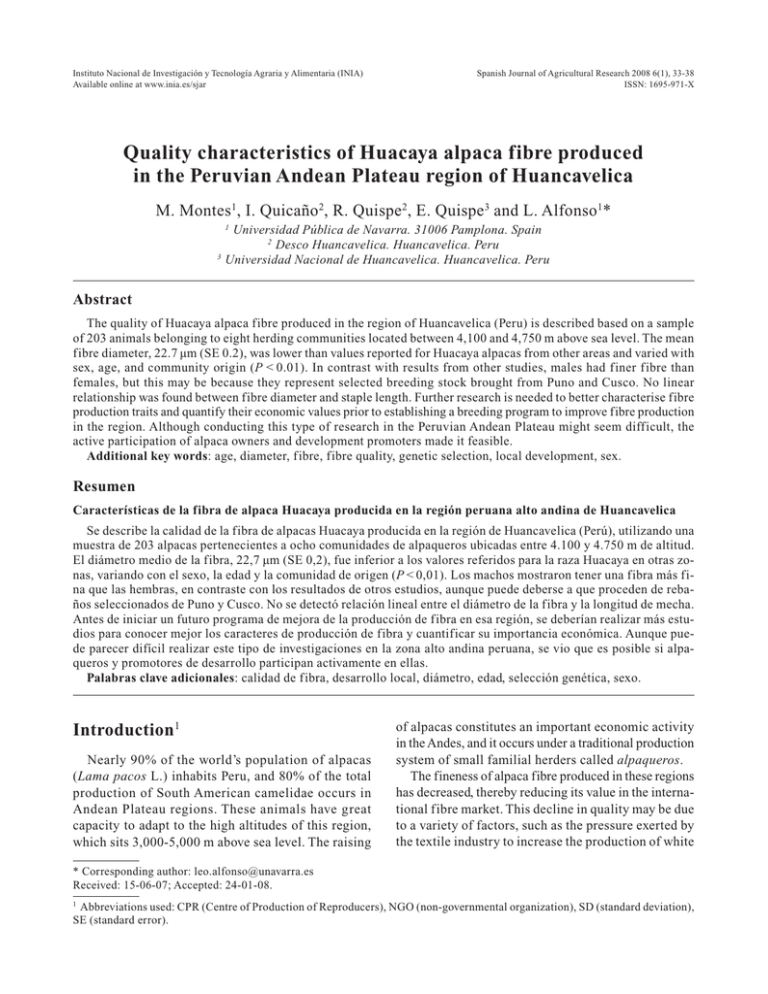
Instituto Nacional de Investigación y Tecnología Agraria y Alimentaria (INIA) Available online at www.inia.es/sjar Spanish Journal of Agricultural Research 2008 6(1), 33-38 ISSN: 1695-971-X Quality characteristics of Huacaya alpaca fibre produced in the Peruvian Andean Plateau region of Huancavelica M. Montes1, I. Quicaño2, R. Quispe2, E. Quispe3 and L. Alfonso1* 1 3 Universidad Pública de Navarra. 31006 Pamplona. Spain 2 Desco Huancavelica. Huancavelica. Peru Universidad Nacional de Huancavelica. Huancavelica. Peru Abstract The quality of Huacaya alpaca fibre produced in the region of Huancavelica (Peru) is described based on a sample of 203 animals belonging to eight herding communities located between 4,100 and 4,750 m above sea level. The mean fibre diameter, 22.7 µm (SE 0.2), was lower than values reported for Huacaya alpacas from other areas and varied with sex, age, and community origin (P < 0.01). In contrast with results from other studies, males had finer fibre than females, but this may be because they represent selected breeding stock brought from Puno and Cusco. No linear relationship was found between fibre diameter and staple length. Further research is needed to better characterise fibre production traits and quantify their economic values prior to establishing a breeding program to improve fibre production in the region. Although conducting this type of research in the Peruvian Andean Plateau might seem difficult, the active participation of alpaca owners and development promoters made it feasible. Additional key words: age, diameter, fibre, fibre quality, genetic selection, local development, sex. Resumen Características de la fibra de alpaca Huacaya producida en la región peruana alto andina de Huancavelica Se describe la calidad de la fibra de alpacas Huacaya producida en la región de Huancavelica (Perú), utilizando una muestra de 203 alpacas pertenecientes a ocho comunidades de alpaqueros ubicadas entre 4.100 y 4.750 m de altitud. El diámetro medio de la fibra, 22,7 µm (SE 0,2), fue inferior a los valores referidos para la raza Huacaya en otras zonas, variando con el sexo, la edad y la comunidad de origen (P < 0,01). Los machos mostraron tener una fibra más fina que las hembras, en contraste con los resultados de otros estudios, aunque puede deberse a que proceden de rebaños seleccionados de Puno y Cusco. No se detectó relación lineal entre el diámetro de la fibra y la longitud de mecha. Antes de iniciar un futuro programa de mejora de la producción de fibra en esa región, se deberían realizar más estudios para conocer mejor los caracteres de producción de fibra y cuantificar su importancia económica. Aunque puede parecer difícil realizar este tipo de investigaciones en la zona alto andina peruana, se vio que es posible si alpaqueros y promotores de desarrollo participan activamente en ellas. Palabras clave adicionales: calidad de fibra, desarrollo local, diámetro, edad, selección genética, sexo. Introduction1 Nearly 90% of the world’s population of alpacas (Lama pacos L.) inhabits Peru, and 80% of the total production of South American camelidae occurs in Andean Plateau regions. These animals have great capacity to adapt to the high altitudes of this region, which sits 3,000-5,000 m above sea level. The raising of alpacas constitutes an important economic activity in the Andes, and it occurs under a traditional production system of small familial herders called alpaqueros. The fineness of alpaca fibre produced in these regions has decreased, thereby reducing its value in the international fibre market. This decline in quality may be due to a variety of factors, such as the pressure exerted by the textile industry to increase the production of white * Corresponding author: [email protected] Received: 15-06-07; Accepted: 24-01-08. 1 Abbreviations used: CPR (Centre of Production of Reproducers), NGO (non-governmental organization), SD (standard deviation), SE (standard error). 34 M. Montes et al. / Span J Agric Res (2008) 6(1), 33-38 f ibre, insuff icient development of technologies to genetically improve the alpaca and its reproduction, inadequate management practices, and loss of high quality animals to other countries (exported both legally and illegally). In addition, alpacas have been crossbred with llamas (Lama glama L.) to increase the amount of fibre produced, but this practice reduces the fineness of the fibre (Fairfield, 2006). About 220,000 alpacas inhabit the Department of Huancavelica, situated in the Southern Sierra region of Peru, which constitutes about 7% of the national stock. More than 90% of alpacas in Huancavelica are of the Huacaya breed, which is characterised by compact, soft, and highly crimped fibres with blunt-tipped locks (Antonini et al., 2004). Nearly 90% of the human population of this area lives in poverty, and as many as 70% live in extreme poverty. In fact, Peru’s alpaca herders are among the very poorest members of Peruvian society. One of the most serious problems that the herders face is the commercialisation of the fibre (De los Ríos, 2006). Producers’ income is based more on quantity than on quality of the fibre. A few processing plants dominate the industry, and intermediaries between producers and processors capture much of the value in the production chain, leaving the herders with very low prices for their fibre (Fairfield, 2006). Consequently, herders are not motivated to improve their management techniques. As a consequence genetic deterioration of the alpaca population seems to have occurred. The objective of this study was to characterise the fineness of alpaca fibre produced in the Huancavelica region to document its present profile and to provide information for future improvements. The effect of sex, age, and community on fibre diameter and the relationship between fibre diameter and staple length were analysed to determine the factors that should be considered when designing a breeding program for the Huacaya alpaca in Huancavelica, Peru. Material and Methods Animals and sampling Fibre samples were obtained during August 2006 from 203 alpacas from eight communities of the Andean Plateau region of Huancavelica in Peru (Astobamba, Cachimayo, Carhuancho, Choclococha, Llillinta, Pilpichaca, Pucapampa, and Santa Ana; these communities lie between 4,100 and 4,750 meters above sea level). Animals belonged to the Centres of Production of Reproducers (CPR) (El Peruano, 2005) and were managed by the communities. The flocks varied in size from 75 and 200 animals, and the proportion of males ranged from 8 to 13%. The management practices were similar in the eight communities and followed the recommendations of the alpaquero calendar (INFOCIT, 2006). Animals were fed in natural pastures. The predominant species, which represented more than 75% of the total, belonged to the families Poaceae, Cyperaceae, Asteraceae and Juncaceae. Any given animal is shorn once a year using scissors, although some communities introduced shearing machines during the last campaign of year 2006. The producers sell the clip to intermediaries, who generally purchase the fibre based on weight rather than quality. Later, these agents class the fibre according to colour and quality for sale to the textile industry [extra fine (≤ 23 µm); fine (> 23 and ≤ 26.5 µm); semi fine (> 26.5 and ≤ 29 µm); and coarse (> 29 µm)] (NTP, 2004). Coloured fleeces are put into the same category as white fleece of the worst quality. Shearing generally occurs at two times of the year —in October-November and in April-May— but animals may be shorn at other times according to the economic necessities of the alpaquero. In this study, animals were shorn once a year in two of the communities (Carhuancho in April-May and Santa Ana in October-November) and twice a year in the other six, with approximately half of alpacas from each community shorn in each period. Samples were obtained from males and females from four different age groups (age based on dental development): < 1.5 years (milk incisors); 1.5-3 years (two permanent incisors); 3-4 years (four permanent incisors); and > 4 years (all permanent incisors). Sample distribution is shown in Table 1. With the exception of the Cachimayo community, in which all alpacas are coloured, only white animals were sampled. Fibre samples were taken from the mid side of the animal; the most representative zone for evaluating the average diameter of the alpaca fibre (Aylan-Parker and McGregor, 2002). Between 6 and 18 g of fibre was taken from both sides of each animal using scissors. The samples were pooled, sealed in plastic bags, and stored for later analysis at the Textile Fibres Laboratory at the Facultad de Zootecnia – Universidad Nacional Agraria La Molina (Lima). Staple length also was recorded for 145 alpacas from six of the eight communities (Astobamba, Carhuancho, Choclococha, Pilpichaca, Pucapampa and Santa Ana). Huacaya alpaca fibre quality in Huancavelica, Peru Table 1. Distribution of sampled alpacas by sex, age and herder community Community Age1 (years) Sex Male Female < 1.5 1.5-3 Astobamba Cachimayo Carhuancho Choclococha Llillinta Pilpichaca Pucapampa Santa Ana 11 8 13 8 5 11 8 11 16 22 16 13 16 14 16 15 8 6 8 8 4 8 8 8 7 6 8 4 5 6 6 7 3-4 >4 7 12 6 5 7 4 5 5 5 6 7 4 5 7 5 6 1 < 1.5 years (milk incisors); 1.5-3 years (two permanent incisors); 3-4 years (four permanent incisors) > 4 years (all permanent incisors). Measurements were taken at mid-rib level from the front, middle, and back of each animal using a millimetre ruler; mean staple length was determined as the average of the three measures. In Cachimayo and Llillinta, it was not technically possible to take the measurements during the sampling period. Fibre analyses Statistical analyses Data on fibre diameter were analysed using general linear models in which sex, age, and community were considered as fixed effects. Effects, standard errors, and significance were computed, and estimates were compared using the LSD test. Pearson’s coefficient of correlation between fibre diameter and staple length also was calculated, with the time of shearing considered. Histograms showing the distribution of mean f ibre diameter and the coefficient of variation of diameter within fleece were generated. Analyses were performed using SPSS software (v.14.0, SPSS Inc., USA). Results More than 60% of alpacas had fleece with mean fibre diameters ≤ 23 µm, which corresponds to the best quality fibres as classified by the NTP (2004); about 4% had fleeces of the worst quality (mean diameters > 29 µm). The fibre diameter of nearly 35% of fleeces had a coefficient of variation < 20%, and only 13% had a coefficient greater than 25% (Fig. 1). Mean fibre diameter was 22.7 µm (SE 0.2). Sex, age, and community explain the observed differences in f ibre diameter (Table 2). Females have coarser fibre (> 1 µm) than males (P < 0.01). Fineness decreases gradually with age (P < 0.01), although differences between younger animals with milk teeth and animals 1.5 or 2 years old were not significant. Communities also differed (P < 0.001), with animals from Cachimayo and Pilpichaca having the coarsest fibre. 20.00 20.00 15.00 15.00 % of animals % of animals Washed and carded samples were tested on the Sirolan Lasercan™ (CSIRO, Australia) following the International Wool Textile Organization Specifications (IWTO12-00). The Sirolan Laserscan™ was calibrated using standard fibre tops, then measurements of mean fibre diameter and the coefficient of variation of fibre diameter within a fleece (%) was recorded for the samples. 10.00 5.00 0.00 ≤17 18 19 20 21 22 23 24 25 26 27 28 29 30 31 ≥31 Mean fibre diameter (µm) µ = 22.7 µm σ = 3.2 µm 35 10.00 5.00 0.00 ≤17 18 19 20 21 22 23 24 25 26 27 28 29 30 31 ≥31 Coefficient of variation of fibre diameter (%) µ = 21.6 µm σ = 3.0 µm Figure 1. The distribution of mean fibre diameter and coefficient of variation of fibre diameter within fleece of Huacaya alpacas. 36 M. Montes et al. / Span J Agric Res (2008) 6(1), 33-38 Table 2. Effect of sex, age and herder community on mean fibre diameter (µm) Factors n1 Fibre diameter2 SE Sex Females Males 0.005 a 128 75 23.19 22.05b 58 49 51 45 a 0.24 0.32 Age < 1.5 years 1.5-3 years 3-4 years > 4 years 0.001 21.65 22.16ab 22.83bc 23.84c 0.36 0.39 0.39 0.42 Community Astobamba Cachimayo Carhuancho Choclococha Llillinta Pilpichaca Pucapampa Santa Ana P-value < 0.001 27 30 29 21 21 25 24 26 a 20.94 24.87b 21.43a 23.04cd 21.88ac 24.39bd 23.22cd 21.19a 0.52 0.50 0.50 0.59 0.60 0.54 0.56 0.53 1 n: number of alpacas. 2 Estimates within a given effect with a common letter were not significantly different at P < 0.05. No linear relationship was found using Pearson’s correlation coefficient between mean fibre diameter and mean staple length. Values were –0.21 (P = 0.07) for the April-May shearing period and 0.07 (P = 0.59) for that in October-November. Discussion The average fibre diameter observed in the eight communities analysed is lower than values reported in other countries: 27.9 µm, USA (Lupton et al., 2006b); 27.5 µm, Australia (Aylan-Parker and McGregor, 2002); 31.9 µm, New Zealand (Wuliji et al., 2000). It also is lower than the values reported in the literature for the Andean region (Apomayta and Gutiérrez, 1998; Wheeler et al., 1995). SPAR-CEPES (2005) reported that in 2005, extra-fine fibre contributed 12% of the total alpaca fibres obtained in Peru. In contrast, 60% of alpacas sampled in our study had fleeces with extrafine fibre. It usually is argued that the large-scale hybridisation between alpacas and llamas that has been conducted in Peru to produce greater fleece weights has reduced the number of purebred alpacas, thereby affecting the quality of fibre (Kadwell et al., 2001). As a result, the diameters of fibres produced by today’s alpacas are considered to be significantly coarser than those of ancient animals. Wheeler et al.’s (1995) analyses of desiccated alpaca mummies from the pre-Inca period (AD 950-1350) suggested the existence of two different groups of alpacas that were differentiated by their average fibre diameter: an extra-fine fibre group (17.8 µm diameter) and a fine fibre group (23.6 µm diameter). Comparing fibre diameter values from the literature with results obtained in this work must be done with caution because f ibre diameter is highly variable. Values can be affected by sampling (Aylan-Parker and McGregor, 2002), measurement techniques (Wuliji et al., 2000), animal characteristics (e.g., colour; Lupton et al., 2006b), and management conditions (McGregor, 2002), and these factors are not always comparable. Nevertheless, our results indicate that the fibre produced in the Huancavelica region is of high quality. The coefficient of variation of mean fibre diameter is another important characteristic of alpaca fleece because it affects the processing performance of the fibre. In alpacas, this coefficient of variation varies greatly with location on the animal’s body (AylanParker and McGregor, 2002), but different descriptive studies have reported similar average values measured from the middle of an animal’s side: 24.3% (SD 4.0) (Aylan-Parker and McGregor, 2002); 23.5% (SD 3.6) (Lupton et al., 2006b); and 23.6% (SD 3.5) (McGregor, 2006). Therefore, although comparison with other results may not be reliable, variation of mean fibre diameter of Huacaya alpacas sampled in our study seems to be lower than in other countries. Both the extra-fine mean f ibre diameter and the low coeff icient of variation suggest that the quality of fibre produced by alpacas in Huancavelica is very good; thus, opportunities exist to improve the incomes of native herders if payment is based on fibre quality instead of fibre weight alone. Our results indicate that sex and age are two endogenous factors that significantly affect fibre diameter. We found that males had finer fibres than did females, which contradicts the general belief that no gender difference exists in alpacas (Apomayta and Gutiérrez, 1998; Wuliji et al., 2000; McGregor and Butler, 2004; Frank et al., 2006; Lupton et al., 2006b) and in other camelids (Martínez et al., 1997; Iñiguez et al., 1998). Aylan-Parker and McGregor (2002) reported the reverse relationship, with f ibre from males being coarser than fibre from females. The most likely reason for the gender difference observed in our study is that Huacaya alpaca fibre quality in Huancavelica, Peru males and females in the CPR have different genetic origins. All of the females were contributed to the CPR by families from each community, whereas a third of the males that were in the CPR during this study came from other Peruvian regions; introduced by the NGO Desco to improve the fibre quality of local alpacas. Those males came mainly from Puno and Cusco, regions with a greater population of alpacas with high quality fibre; they belonged to the Peruvian Alpaca Genealogical Registry (Puno); and they had been chosen previously for the quality of their fibre or had won awards in a fair. Thinking in genetic evaluation terms, in a scenario where a selection process is to be started, the difference between sexes should be carefully analysed. Confounding effects of sex and genetic origin should be avoided and genetic groups should may be considered in the animal model (Westell et al., 1988). With respect to age, differences in fibre diameter between animals older and younger than 3 years were found, which agrees with the generally accepted concept that f ibre diameter increases with age. However, McGregor (2002) discussed how simplistic this concept can be if other conditions, such as nutrition, are not considered. McGregor pointed out that when adult alpacas lost weight due to nutritional conditions, they also grew less fibre, and the decline in fibre growth was associated with a decline in fibre diameter. Lupton et al. (2006a) found that young alpacas that received 20% more feed produced more fibre that tended to be slightly coarser. In the Peruvian Andes, there is a general belief that a relationship exists between elevation and alpaca fibre fineness, although this premise has yet to be concretely demonstrated (Wheeler et al., 1995). However, Braga et al. (2007) recently reported that within the normal elevation range for alpacas in the Peruvian highlands (4,100-4,700 m), changes in altitude alone would be expected to have little or no effect on alpaca fibre characteristics, but diet might have a major influence. Thus, we hypothesise that the fine fibre observed in the alpacas from the Huancavelica region could be related to the poor conditions of their natural pastures rather than to their genetic characteristics. Alpacas from the Pilpichaca and Cachimayo communities had significantly greater mean fibre diameters than did animals from the other six communities. These differences are difficult to explain. However, of the eight communities, Pilpichaca lies at the lowest altitude above sea level (4,100 m vs. 4,480-4,750 m) and perhaps the pastures provide alpacas with better nutritional conditions compared to the other seven communities. In addition, 37 the proportion of males imported to Pilpichaca from other origins was the lowest of all of the communities. Cachimayo alpacas had coloured fleeces, which might account for the greater fibre diameters measured in this community. However, the literature on the relationship between fleece colour and mean fibre diameter is varied. Some studies report no significant differences among colours (Wuliji et al., 2000), others state that that dark colours are coarser than those classified as light (McGregor and Butler, 2004; Lupton et al., 2006b), and Frank et al. (2006) discussed studies indicating that black fleeces are finer than white. Although the economic value of fleece depends greatly on mean fibre diameter, staple length also is an important trait. For the Huacaya alpacas studied, no linear relationship was found between mean f ibre diameter and staple length. Results are not consistent in the literature: Lupton et al. (2006b) found a negative correlation between these parameters for alpacas in the USA, whereas Wuliji et al. (2000) reported a positive correlation in New Zealand alpacas. Thus, the relationship between fibre diameter and staple length in alpacas bred for fibre production does not seem to be a necessary consideration when starting a genetic breeding program. Genetic studies in alpacas suggest that the f ibre diameter trait can be improved by selection, with heritability estimates ranging from 0.18 to 0.73 (Wuliji et al., 2000; León-Velarde and Guerrero, 2001; McGregor and Butler, 2004; Frank et al., 2006). However, the environmental factors that affect fibre diameter are not always well understood and some seem to have contradictory effects. In the Huancavelica region, age and herder community are factors that should be considered when establishing a genetic breeding program. In addition, the relationship between fibre diameter and both sex and genetic origin should be clarif ied. In general, more research is needed to determine more accurately the relationship between fibre diameter and these and other factors (e.g., fleece colour). Quantifying the relative economic value of fibre attributes, as it has been done in other locations (McGregor, 2006), also is necessary. Although conducting this type of research in the Peruvian Andean Plateau might seem difficult, this work has shown its feasibility when alpaca owners and promoters participate with the belief that current conditions can be improved. Nevertheless, price incentive in the herder’s sales fleece for quality is, with all probability, an essential requirement in a medium term scenario, previous to introduce a selection program participated by families and communities. 38 M. Montes et al. / Span J Agric Res (2008) 6(1), 33-38 Acknowledgements We thank all of the alpaqueros who contributed to this study and the Universidad Nacional de la Molina (Textile Fibres Laboratory, Facultad de Zootecnia) for the f ibre quality analysis. Universidad Pública de Navarra and Gobierno de Navarra provided financial support for this work. References ANTONINI M., GONZALES M., VALBONESI A., 2004. Relationship between age and postnatal skin follicular development in three types of South American domestic camelids. Livest Prod Sci 90, 241-246. APOMAYTA Z.J., GUTIÉRREZ G.A., 1998. Evaluación de las características tecnológicas y productivas de la fibra en alpacas Huacaya esquiladas a los 12 y 17 meses de edad. Anales Científicos UNALM 36, 35-42. [In Spanish]. AYLAN-PARKER J., MCGREGOR B.A., 2002. Optimising sampling techniques and estimating sampling variance of fleece quality attributes in alpacas. Small Rumin Res 44, 53-64. BRAGA W., LEYVA V., COCHRAN R., 2007. The effect of altitude on alpaca (Lama pacos) fiber production. Small Rumin Res 68, 323-328. DE LOS RÍOS E., 2006. Producción textil de f ibras de camélidos sudamericanos en el área altoandina de Bolivia, Ecuador y Perú. United Nations Industrial Development Organization (UNIDO), Brussels. [In Spanish]. EL PERUANO, 2005. Ley de promoción del mejoramiento genético y conservación de las razas de camélidos sudamericanos domésticos, El Peruano, Normas legales, 0222005-AG, 5 de mayo de 2005, p. 291992. [In Spanish]. FAIRFIELD T., 2006. The politics of livestock sector policy and the rural poor in Peru. Pro-Poor Livestock Policy Initiative (PPLPI) Working Paper No. 32, FAO, Rome. FRANK E.N., HICK M.V.H., GAUNA C.D., LAMAS H.E., RENIERI C., ANTONINI M., 2006. Phenotypic and genetic description of fibre traits in South American domestic camelids (llamas and alpacas). Small Rumin Res 61, 113-129. INFOCIT, 2006. Calendario de manejo y sanidad de alpacas en la Sierra Central del Perú. Boletín Electrónico CIT INFORMA, Instituto Nacional de Investigación Agraria, Perú, No. 1/2006 [online]. Available in http:// www.inia.gob.pe/boletin/bcit. [May 2007] [In Spanish]. IÑIGUEZ L.C., ALEM R., WAUER A., MUELLER J., 1998. Fleece types, fiber characteristics and production systems of an outstanding llama population from Southern Bolivia. Small Rumin Res 30, 57-65. KADWELL M., FERNÁNDEZ M., STANLEY H.F., BALDI R., WHEELER J.C., ROSARIO R., BRUFORD M.W., 2001. Genetic analysis reveals the wild ancestors of the llama and the alpaca. Proc Biol Sci 268, 2575-2584. LEÓN-VELARDE C., GUERRERO J., 2001. Improving quantity and quality of Alpaca fiber; using a simulation model for breeding strategies. Proc Third Intnl Symposium on Systems Approaches for Agricultural Development International Potato Center (CIP), Lima, Peru. p. 9. [CDROM]. LUPTON C.J., ELVESTAD R.P., PFEIFFER F.A., MACKINNON K., 2006a. Effects of age, location, and nutrition on body weight, f iber production, and f iber quality characteristics of penned alpaca males. J Anim Sci 84 (Suppl. 1), 58. LUPTON C.J., McCOLL A., STOBART R.H., 2006b. Fiber characteristics of the Huacaya Alpaca. Small Rumin Res 64, 211-224. MARTÍNEZ Z., IÑIGUEZ L.C., RODRÍGUEZ T., 1997. Influence of effects on quality traits and relationships between traits of the llama fleece. Small Rumin Res 24, 203-212. McGREGOR B.A., 2002. Comparative productivity and grazing behaviour of Huacaya alpacas and Peppin Merino sheep grazed on annual pastures. Small Rumin Res 44, 219-232. McGREGOR B.A., 2006. Production, attributes and relative value of alpaca fleeces in southern Australia and implications for industry development. Small Rumin Res 61, 93-111. McGREGOR B.A., BUTLER K.L., 2004. Sources of variation in fibre diameter attributes of Australian alpacas and implications for fleece evaluation and animal selection. Aus J Agric Res 55, 433-442. NTP, 2004. Peruvian practical standards of the fibre of alpaca. Normas técnicas peruanas 231.300, 231.301. INDECOPI. [In Spanish]. SPAR-CEPES, 2005. Producción y comercialización de fibra de alpaca. Sociedad Peruana de Criadores de Alpacas y Llamas Registradas. Centro Peruano de Estudios Sociales. Miski paqu. Boletín informativo 1, 2-4. [In Spanish]. WESTELL R.A., QUAAS R.L., VAN VLECK L.D., 1988. Genetic groups in an animal model. J Dairy Sci 71, 13101318. WHEELER J.C., RUSSEL A.J.F., REDDEN H., 1995. Llamas and alpacas: pre-conquest breeds and post-conquest hybrids. J Archaeol Sci 22, 833-840. WULIJI T., DAVIS G.H., DODDS K.G., TURNER P.R., ANDREWS R.N., BRUCE G.D., 2000. Production performance, repeatability and heritability estimates for live weight, fleece weight and fiber characteristics of alpacas in New Zealand. Small Rumin Res 37, 189-201.
